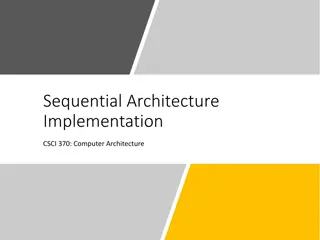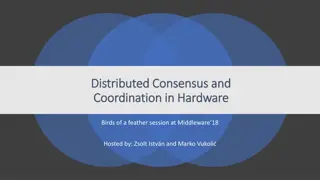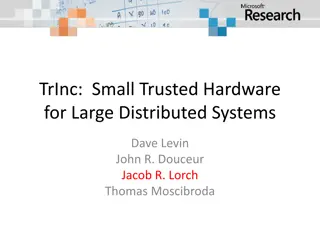Hardware Security and Trusted Platform Module Overview
This content discusses the importance of hardware security, distinguishing it from software security, and introduces the concept of Trusted Platform Module (TPM) as a trusted co-processor integrated into the platform to enhance security. It also highlights the role of the Trusted Computing Group (TCG) in developing hardware and software standards for improved security measures.
Download Presentation

Please find below an Image/Link to download the presentation.
The content on the website is provided AS IS for your information and personal use only. It may not be sold, licensed, or shared on other websites without obtaining consent from the author. Download presentation by click this link. If you encounter any issues during the download, it is possible that the publisher has removed the file from their server.
E N D
Presentation Transcript
Content may be borrowed from other resources. See the last slide for acknowledgements! Hardware Security: Trusted Platform Module Amir Houmansadr CS660: Advanced Information Assurance Spring 2015
Hardware Security Definition: implement security protection mechanisms in hardware E.g., design trusted hardware, as opposed to (in addition to) trusted software CS660 - Advanced Information Assurance - UMassAmherst 2
Trusted or Trustworthy A component of a system is trusted means that the security of the system depends on it failure of component can break the security policy determined by its role in the system A component is trustworthy means that the component deserves to be trusted e.g., it is implemented correctly determined by intrinsic properties of the component Trusted or trustworthy computation? CS660 - Advanced Information Assurance - UMassAmherst 3
Why Hardware Security Software security: software protect software! Vulnerable to attacks Is the antivirus/hardware untouched? Easy infiltration Fast spread Hardware security: hardware protect software Attacks need physical access Software infiltration much more difficult CS660 - Advanced Information Assurance - UMassAmherst 4
Trusted Platform Module (TPM) A chip integrated into the platform The (alleged) purpose is to provide more security It is a separate trusted co-processor The TPM represents a separate trusted coprocessor, whose state cannot be compromised by potentially malicious host system software. IBM Research Report CS660 - Advanced Information Assurance - UMassAmherst 5
The Trusted Computing Group The Trusted Computing Group (TCG) is a non-profit industry consortium, which develops hardware and software standards. It is funded by many member companies, including IBM, Intel, AMD, Microsoft, Sony, Sun, and HP among others. CS660 - Advanced Information Assurance - UMassAmherst 6
Attestation The TPM's most controversial feature is attestation, the ability to measure the state of a computer and send a signed message certifying that particular hardware or software is or isn't present. Controversial Provide features that can be used to secure hardware against the owner CS660 - Advanced Information Assurance - UMassAmherst 7
Components Root key PKI private keys could be stored in the chip PK signatures calculated in the chip itself, never visible outside Random number generators SHA-1 encryption Monotonic counters Process isolation (encrypted I/O, prevents keystroke loggers, screen scrapers) CS660 - Advanced Information Assurance - UMassAmherst 8
Goals TPMs allow a system to: Gather and attest system state Store and generate cryptographic data Prove platform identity Prevents unauthorized software Helps prevent malware CS660 - Advanced Information Assurance - UMassAmherst 9
TPMs Novelty Not much novel crypto! Most, if not all, of the security ideas already exist What TPMs bring to the table is a secure sealed storage chip for private keys, on-chip crypto, and random number generators among others The state of the TPM can not be compromised by malicious host software CS660 - Advanced Information Assurance - UMassAmherst 10
Limitations Advanced features will require O/S support Potential for abuse by Software vendors Co-processor or Cop-processor? Trusted Computing requires you to surrender control of your machine to the vendors of your hardware and software, thereby making the computer less trustworthy from the user s perspective Ross Anderson CS660 - Advanced Information Assurance - UMassAmherst 11
Real-World Applications Hard drive encryption BitLocker in Windows 8 Trustworthy OS Google s Chromebook use TPM to prevent firmware rollback Potential applications: DRM Fighting pirate software CS660 - Advanced Information Assurance - UMassAmherst 12
BitLocker Drive Encryption BitLocker Drive Encryption gives you improved data protection on your Windows Notebooks Often stolen, easily lost in transit Desktops Often stolen, difficult to safely decommission Servers High value targets, often kept in insecure locations All three can contain very sensitive IP and customer data Designed to provide a transparent user experience that requires little to no interaction on a protected system Prevents thieves from using another OS or software hacking tool to break OS file and system protections Prevents offline viewing of user data and OS files Provides enhanced data protection and boot validation through use of a Trusted Platform Module (TPM) CS660 - Advanced Information Assurance - UMassAmherst 13
BitLocker Drive Encryption Architecture Static Root of Trust Measurement of boot components PreOS Static OS All Boot Blobs unlocked Volume Blob of Target OS unlocked TPM Init BIOS MBR BootSector BootBlock BootManager Start OS OS Loader
Disk Layout And Key Storage OS Volume Contains Encrypted OS Encrypted Page File Encrypted Temp Files Encrypted Data Encrypted Hibernation File Where s the Encryption Key? 1. SRK (Storage Root Key) contained in TPM 2. SRK encrypts FVEK (Full Volume Encryption Key) protected by TPM/PIN/USB Storage Device 3. FVEK stored (encrypted by SRK) on hard drive in the OS Volume 3 OS Volume 2 FVEK 1 SRK System System Volume Contains: MBR, Boot manager, Boot Utilities (Unencrypted, small)
Spectrum of Protection BitLocker offers a spectrum of protection, allowing an organization to customize according to its own needs Ease of Deployment / Maintenance TPM Only What it is TPM + USB What it is + what you have Protects Against: HW attacks Vulnerable To: Stolen USB key USB Only What you have TPM + PIN What it is + what you know Protects Against: Many HW attacks Vulnerable To: Hardware attacks Protects Against: HW attacks Vulnerable To: Stolen USB key No boot validation User Must: Protect USB key Protects Against: Most SW attacks Vulnerable To: Hardware attacks User Must: Protect USB key User Must: Enter PIN to boot User Must: N/A No user impact
More Hardware Security USB tokens RSA SecureID Smart Cards CPU-level techniques Encryption disks CS660 - Advanced Information Assurance - UMassAmherst 17
cTPM: A Cloud TPM for Cross-Device Trusted Applications Slides from authors at NSDI 14
Acknowledgement Some of the slides, content, or pictures are borrowed from the following resources, and some pictures are obtained through Google search without being referenced below: 1. RandyFort, Trusted Platform Modules, class lecture 2. Shon Eizenhoefer, BitLocker Drive Encryption Hardware Enhanced Data Protection CS660 - Advanced Information Assurance - UMassAmherst 19























